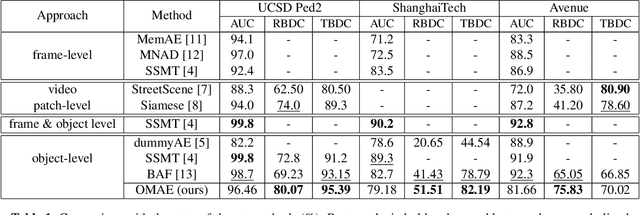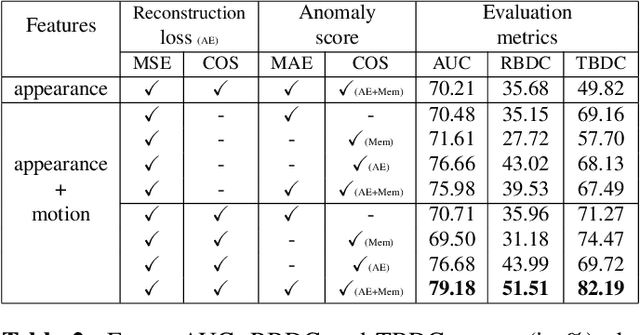Aleksandr Setkov
Spatio-temporal predictive tasks for abnormal event detection in videos
Oct 27, 2022Abstract:Abnormal event detection in videos is a challenging problem, partly due to the multiplicity of abnormal patterns and the lack of their corresponding annotations. In this paper, we propose new constrained pretext tasks to learn object level normality patterns. Our approach consists in learning a mapping between down-scaled visual queries and their corresponding normal appearance and motion characteristics at the original resolution. The proposed tasks are more challenging than reconstruction and future frame prediction tasks which are widely used in the literature, since our model learns to jointly predict spatial and temporal features rather than reconstructing them. We believe that more constrained pretext tasks induce a better learning of normality patterns. Experiments on several benchmark datasets demonstrate the effectiveness of our approach to localize and track anomalies as it outperforms or reaches the current state-of-the-art on spatio-temporal evaluation metrics.
Object-centric and memory-guided normality reconstruction for video anomaly detection
Mar 07, 2022


Abstract:This paper addresses video anomaly detection problem for videosurveillance. Due to the inherent rarity and heterogeneity of abnormal events, the problem is viewed as a normality modeling strategy, in which our model learns object-centric normal patterns without seeing anomalous samples during training. The main contributions consist in coupling pretrained object-level action features prototypes with a cosine distance-based anomaly estimation function, therefore extending previous methods by introducing additional constraints to the mainstream reconstruction-based strategy. Our framework leverages both appearance and motion information to learn object-level behavior and captures prototypical patterns within a memory module. Experiments on several well-known datasets demonstrate the effectiveness of our method as it outperforms current state-of-the-art on most relevant spatio-temporal evaluation metrics.
PaDiM: a Patch Distribution Modeling Framework for Anomaly Detection and Localization
Nov 17, 2020



Abstract:We present a new framework for Patch Distribution Modeling, PaDiM, to concurrently detect and localize anomalies in images in a one-class learning setting. PaDiM makes use of a pretrained convolutional neural network (CNN) for patch embedding, and of multivariate Gaussian distributions to get a probabilistic representation of the normal class. It also exploits correlations between the different semantic levels of CNN to better localize anomalies. PaDiM outperforms current state-of-the-art approaches for both anomaly detection and localization on the MVTec AD and STC datasets. To match real-world visual industrial inspection, we extend the evaluation protocol to assess performance of anomaly localization algorithms on non-aligned dataset. The state-of-the-art performance and low complexity of PaDiM make it a good candidate for many industrial applications.
 Add to Chrome
Add to Chrome Add to Firefox
Add to Firefox Add to Edge
Add to Edge